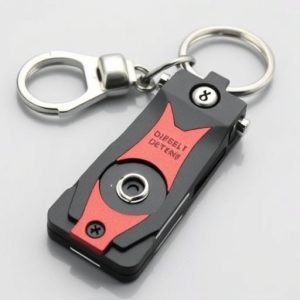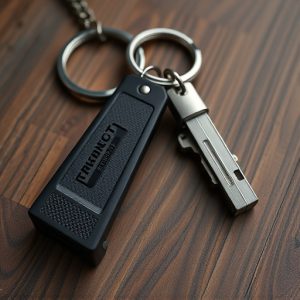Designing Pocket-Sized Keychain Defense Weapons: Metal, Grip, and Functionality
Designing pocket-sized keychain defense weapons requires selecting durable materials like stainless…….
Designing pocket-sized keychain defense weapons requires selecting durable materials like stainless steel or titanium for longevity and corrosion resistance, prioritizing ergonomic design for user comfort and control, incorporating sharp edges and strategic locking mechanisms for self-defense, and balancing compactness with functionality through lightweight materials and precision engineering to offer both convenience and reliable protection.
In today’s world, self-defense is a serious consideration. For those seeking a compact and convenient option, pocket-sized keychain defense weapons offer a unique blend of functionality and portability. This article guides you through the essential aspects of designing an effective metal keychain grip, from material selection to ergonomic design and built-in defense features. We’ll explore how to create a powerful yet user-friendly tool that fits comfortably in your pocket, ready for any situation.
- Choosing the Right Metal for Durability and Corrosion Resistance
- Keychain Grip Design Principles for Enhanced Ergonomics and Control
- Incorporating Self-Defense Features: From Edges to Locking Mechanisms
- Compact Size Considerations: Balancing Functionality and Pocket Convenience
Choosing the Right Metal for Durability and Corrosion Resistance
When designing a pocket-sized keychain defense weapon, selecting the appropriate metal is paramount for both durability and corrosion resistance. Opting for high-quality stainless steel or titanium alloys ensures your keychain grip stands the test of time, even with frequent use. These metals offer exceptional strength-to-weight ratios, making them ideal for compact, portable self-defense tools. Stainless steel, in particular, is known for its ability to withstand harsh conditions and maintain a lustrous finish, while titanium’s lightweight nature adds to the overall convenience of carrying a defense keychain.
Corrosion resistance is a critical factor, especially if your keychain will be exposed to varying environments. Metals like aluminum might seem appealing due to their lightness, but they are more susceptible to corrosion, which can compromise the integrity of the grip over time. By choosing materials that offer both durability and protection against rust or oxidation, you ensure your pocket-sized keychain defense weapon remains reliable and functional, providing peace of mind when it matters most.
Keychain Grip Design Principles for Enhanced Ergonomics and Control
When designing a pocket-sized keychain defense weapon, ergonomics and control should be the primary focus to ensure user comfort and effectiveness. The grip section of your keychain should be tailored to fit comfortably within the palm of the user’s hand, with a shape that promotes a secure, non-slip grasp. Incorporate texturing or contoured surfaces to enhance friction, making it easier to hold onto in various conditions and during intense use.
Consider the user’s thumb position and how it interacts with the rest of their grip. A well-placed thumb rest or recess can significantly improve control and stability, allowing for quicker and more precise movements. Additionally, balance is key; distribute weight evenly across the keychain to maintain control when swinging or throwing, ensuring that your pocket-sized defense weapon performs as intended in emergency situations.
Incorporating Self-Defense Features: From Edges to Locking Mechanisms
Incorporating self-defense features into a pocket-sized keychain weapon design is a smart way to enhance its utility beyond a simple storage tool. Keychain defense items, often in the form of small knives or tools, can become powerful personal safety devices with strategic additions. One such feature is a sharp, durable edge designed for cutting and self-defense, ensuring it can serve as a reliable tool in various situations.
Additionally, locking mechanisms are crucial for securing the weapon’s deployment. A simple yet effective lock can prevent accidental opening, allowing users to activate the device only when needed. This adds another layer of safety and control, making pocket-sized keychain defense weapons versatile tools that combine convenience with personal security.
Compact Size Considerations: Balancing Functionality and Pocket Convenience
When designing a pocket-sized keychain defense weapon, size is paramount. The challenge lies in balancing functionality and convenience. A compact design appeals to users who want a discreet self-defense option that fits comfortably in their pockets. However, reducing size can compromise the weapon’s effectiveness. Therefore, designers must prioritize key features while minimizing bulk. This often involves using lightweight materials and precision engineering to create a sturdy yet thin device.
Considerations like ease of deployment and grip comfort become crucial. A well-designed keychain defense tool should be easily accessible and provide a secure grip for quick, confident use. Additionally, incorporating features like a sharp point or multiple striking surfaces can enhance its functionality without significantly increasing size. Ultimately, the goal is to create a pocket-sized keychain defense weapon that offers both convenience and reliable protection.
When designing a pocket-sized keychain defense weapon, striking the right balance between functionality, durability, and convenience is key. By selecting the appropriate metal for both corrosion resistance and strength, implementing ergonomic grip designs for better control, integrating self-defense features like sharp edges or locking mechanisms, and ensuring the final product fits comfortably in your pocket, you can create an effective and accessible personal safety tool. Remember, the best keychain defense solution combines form with function.


